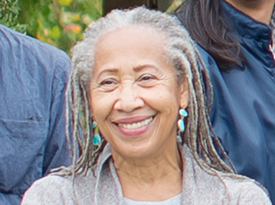 Next week, we’re hosting an event about some exciting proposed changes for urban agriculture in Berkeley, which could result in more food to be grown on vacant lots and other spaces. Berkeley has a solid existing network of school, nonprofit, and community gardens – but wait lists are long, and more gardening space is in high demand. To get the lay of the land, we interviewed Corinne Haskins, the coordinator of Berkeley Community Gardening Collaborative, (a fiscally sponsored project of the Ecology Center). Enjoy, and we hope you will come to next week’s event to learn more.
Next week, we’re hosting an event about some exciting proposed changes for urban agriculture in Berkeley, which could result in more food to be grown on vacant lots and other spaces. Berkeley has a solid existing network of school, nonprofit, and community gardens – but wait lists are long, and more gardening space is in high demand. To get the lay of the land, we interviewed Corinne Haskins, the coordinator of Berkeley Community Gardening Collaborative, (a fiscally sponsored project of the Ecology Center). Enjoy, and we hope you will come to next week’s event to learn more.
Ecology Center: What projects have you been working on since taking over coordination of Berkeley Community Gardening Collaborative (BCGC) last year?
Corinne Haskins: The first project I worked on was the Gill Tract Community Farm fundraising event during a week of Earth Day Celebrations. BCGC for the first time participated in the annual Berkeley Harvest Festival. Gardeners provided demos on composting, traditional uses of herbals and medicinal herbs as well, and cultivating pollinators for the gardens. Harvest Festival goers got to tour three of the BCGC gardens. The collaborative gave out seeds and swapped garden produce and seeds, too. Children were able to decorate pots and pot a variety of plants of their choosing. Approximately 2,000 people attended! We’re gearing up for Cal Student Volunteer weekend in March. This is a time when sprucing up beds or plots for spring planting and revamping tool shed storage or whatever else gardeners need transpires.
EC: Tell us what a typical week looks like – what do you do?
CH: It involves weekly correspondence with BCGC members and community partners – responding to public inquiries, community outreach, and attending meetings. I also deliver compost to gardens once a month.
EC: We’re excited to learn more about City of Berkeley’s new Urban Ag package at the event next week. What do you think the new policy will mean for community gardens in Berkeley?
CH: The proposed Urban Agricultural Package will provide guidelines on how and what type of gardening can be done and where – rooftop, hillside, residential, and commercial spaces will be available to the public. For example, property owners not using vacant land can increase community food security by allowing neighbors to garden in that space in return for a tax credit.
EC: Say someone wanted to start a new community garden. How would they begin?
CH: When residents call me, I offer to come out and visit the proposed site and answer questions on what it takes to start up. There is a community garden handbook on the Ecology Center site that I suggest people upload and read. There are important considerations for how garden groups may organize (dues, site work days, and expectations on plot maintenance). I also suggest that they visit our garden sites for ideas and to speak with the coordinators at those sites. Contact info for each garden is on the BCGC brochure and website.
EC: We know available land for community gardens is scarce in Berkeley, and what land is available may have pollutants in the soil left from past uses that haven’t been cleaned up – like the Santa Fe Right-of-Way. What do you think the best solution is for sites that have contaminated soil?
CH: Well, obviously much depends on the type of contamination. The SFROW has high levels of arsenic, which makes for an arduous clean up process at present. UC Berkeley’s Department of Environmental Science, Policy, and Management is using Chinese Brake Ferns (planting, extracting and repeating until the ferns have removed the toxin). Most gardeners will want to test soil for lead as a first step to establishing a garden. Alameda County has pamphlets on this topic and you can visit its website for specific solutions, too. The Ecology Center has info, as do most nurseries. Once a gardener has extracted soil, samples can be submitted to local labs for testing.
EC: Do you garden? What do you like to grow?
CH: Yes, I do. Depends on my mood! Chinese Long Beans, tomatoes, potatoes, cabbage, squash….
EC: Do you have a favorite garden that you recommend for folks to visit who are interested in community gardens?
CH: All of the gardens are unique. Some have bees, some have chickens, and most have plots. I prefer BYA (Berkeley Youth Alternative) Production Garden and the Gill Tract, because I am into permaculture techniques. These gardens have no plots but rows with swales between them to retain water. Straw or green composting is a strategy for also reducing water usage and to cut down on those plants not wanted. Rows also allow for more gardeners to engage, whereas plots are limiting because you segment the space and one person has the spot as long as they work it which means there’s a waiting list. At this point some sites, on average, have a two year waiting list.



